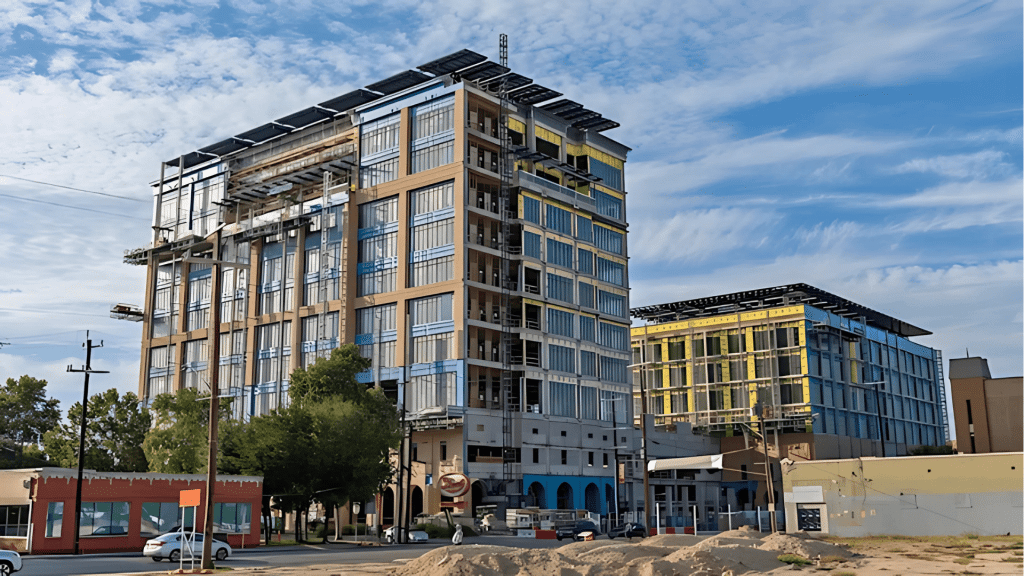Planning a new home is exciting, but it also comes with big questions. One of the first things you need to know is your construction cost per square foot.
Knowing this number gave me a solid starting point for my budget. I could take my planned square footage, multiply it by the local rate, and get a realistic idea of my base cost.
I’ll walk you through what’s included in that number, what can make it go up or down, and how it changes from state to state.
You’ll also see examples, so you can plan with confidence and avoid the surprises that catch many homeowners off guard.
National Ranges for Construction Cost per Square Foot
Understanding the average construction cost per square foot can help you plan your budget with more confidence.
These figures vary based on location, building type, and project complexity, but national ranges give a helpful starting point for estimates.
| Finish Level | Cost Per Square Foot |
|---|---|
| Basic | $100 – $130 |
| Mid-Range | $130 – $180 |
| Custom | $180 – $300+ |
Factors that push costs higher:
Certain choices and conditions can quickly increase your construction costs. Here are some key factors that can push your price per square foot higher:
- Complex roof lines
- High-end materials
- Multiple stories
- Remote locations
- Tight labor markets
Costs per Square Foot by Location
Construction costs can shift significantly depending on where you’re building. Factors like labor rates, material availability, and regional demand all play a role.
Comparing location-based averages helps you set realistic expectations and align your project with your budget.
State Averages
Construction costs vary widely across the country. Here’s what you can expect by region:
Lower cost states: $90 – $120 per square foot
- Alabama, Mississippi, Arkansas
- Rural areas with lower labor costs
Average cost states: $120 – $160 per square foot
- Texas, Florida, North Carolina
- Growing markets with steady demand
Higher cost states: $160 – $250+ per square foot
- California, New York, Massachusetts
- Urban areas with expensive labor and materials
City and Zip Code Factors
Urban areas typically cost 20 – 40% more than rural locations. Labor rates drive most of this difference.
Climate affects costs, too. Cold regions need better insulation and heating systems. Areas with hurricanes or earthquakes require special construction methods.
Building codes also vary. Some cities have stricter energy requirements or fire safety rules that add to your budget.
Market Examples
To give a clearer sense of how construction costs vary across the country, here are sample estimates from three very different markets:
| Market Type | 1,500 sq ft | 2,000 sq ft | 2,500 sq ft |
|---|---|---|---|
| Low-cost (Rural Alabama) | $135,000 – $165,000 | $180,000 – $220,000 | $225,000 – $275,000 |
| Average (Austin, Texas) | $195,000 – $240,000 | $260,000 – $320,000 | $325,000 – $400,000 |
| High-cost (San Jose, California) | $300,000 – $375,000 | $400,000 – $500,000 | $500,000 – $625,000 |
These figures reflect typical price ranges for new home construction in each area and can help you understand how location influences your budget.
What “Cost per Square Foot” Includes (and What It Doesn’t)
When looking at construction cost per square foot, it’s important to know what’s part of the calculation and what’s not. Here’s what to know:
| Included | Not Included |
|---|---|
| Foundation and framing | Land purchase |
| Roofing and siding | Utility connections to the street |
| Interior walls and flooring | Landscaping and driveways |
| Basic kitchen and bathroom fixtures | Architectural design fees |
| Standard electrical, plumbing, and HVAC | Building permits |
| Insulation and drywall | Appliances and furniture |
| Garage or outbuildings |
Tip: These boundaries can vary by builder, so always confirm exactly what’s covered in your estimate before comparing prices.
Construction Soft Costs and Site Costs
Beyond the base construction price, there are additional expenses that cover planning, permits, and preparing the building site.
These costs can significantly impact your overall budget and should be factored in early. Here’s what to know about construction soft costs and site costs:
Soft Costs (15-25% of construction)
Soft costs cover the behind-the-scenes expenses that keep your project moving, from design fees to permits. Here’s what typically falls into the 15–25% range:
- Architectural plans: $5,000 – $15,000
- Engineering: $2,000 – $8,000
- Building permits: $1,000 – $5,000
- Inspections: $500 – $2,000
Site Work Ranges
Site preparation can vary widely in cost depending on the location and condition of your land. Here’s a look at common site work ranges to help you budget:
- Basic grading: $2,000 – $5,000
- Septic system: $8,000 – $15,000
- Well drilling: $3,000 – $10,000
- Long driveways: $3,000 – $12,000
- Rock removal: $5,000 – $20,000
Design and Specification Drivers
The design choices and specifications you select for your home can have a big impact on overall costs. Here are the main factors that often influence the final price:
- Foundation type matters. Slab foundations cost less than full basements. Crawl spaces fall in the middle.
- More stories mean higher costs. Two-story homes need more complex framing and additional stairs.
- Roof complexity adds expense. Simple gable roofs cost less than hip roofs with multiple dormers.
- Kitchen and bathroom count. These rooms have the highest cost per square foot due to plumbing, electrical, and fixtures.
- Material choices make a big difference. Vinyl siding costs much less than stone or brick.
Market Notes and Trends
Material costs have stabilized after the big increases of recent years. Lumber prices remain higher than pre-pandemic levels, but aren’t spiking anymore.
Labor shortages continue in most markets. This keeps wages high and can extend construction timelines. Supply chain issues have mostly resolved. Most materials arrive on schedule now.
Interest rates affect your construction loan costs. Higher rates mean higher carrying costs during the build process.
Timing your build
When you choose to start construction can affect both your budget and your timeline. Here’s what to consider when timing your build:
- Start planning 6-12 months ahead
- Get multiple bids early
- Lock in your construction loan rate when possible
- Plan for weather delays in your timeline
Commercial Construction Cost per Square Foot

Commercial construction costs can vary even more widely than residential projects, depending on the type of building, its purpose, and the required specifications.
Understanding these averages can help set realistic expectations before diving into project planning.
Typical Ranges
Here’s an overview of the typical cost ranges you can expect, helping you see what your project is might fall and plan your budget more accurately:
- Office Buildings: Class A $200–$300, Class B $150–$220, Class C $100–$170 per sq ft
- Retail Spaces: Strip centers $120–$180, shopping malls $180–$250, standalone stores $140–$200 per sq ft
- Warehouse & Industrial: Basic warehouse $60–$90, manufacturing $80–$120, cold storage $150–$200 per sq ft
Regional Premiums
In some locations, especially large metropolitan areas, building costs can be much higher than the national average. Here’s how regional premiums can impact your budget:
- New York City: Add 40-60% to national averages
- San Francisco: Add 35-50% to national averages
- Washington, DC: Add 25-35% to national averages
- Seattle: Add 20-30% to national averages
- Denver: Add 15-25% to national averages
Core and Shell vs. Tenant Improvements
Commercial projects are split into two main categories:
Core and shell cover the basic building structure, roof, exterior walls, and utilities in each space. This typically runs $80-150 per square foot.
Tenant improvements (TI) include interior build-out, flooring, lighting, and finished surfaces. Budget $30-100 per square foot, depending on the use.
Common Mistakes to Avoid
Avoiding a few common pitfalls can save you time, money, and stress during your build. Here are the mistakes to watch out for when planning your project:
- Underestimating soft costs: Planning fees, permits, and engineering can add 15–25% to your base construction cost.
- Skipping a contingency fund: Unexpected expenses are almost guaranteed. Set aside at least 10–15% for surprises.
- Not accounting for site work: Driveways, grading, or rock removal can add thousands if not budgeted from the start.
- Choosing materials too late: Last-minute selections can delay schedules and increase costs due to rush orders.
- Failing to confirm what’s included: Builders vary in what they cover for the quoted cost per square foot.
Taking these into account early helps prevent cost overruns and project delays.
Summing Up
Planning a new home is a big project, and knowing your construction cost per square foot gives you a strong starting point.
It’s the number that helps you see how size, finishes, and location all shape your budget.
I’ve shared what’s usually included, what’s not, and how costs shift from one area to another. You’ve also seen how extras like soft costs and site work fit into the bigger picture.
Now it’s your turn to put the numbers to work. Use them to plan smarter, talk with local builders, and keep your budget realistic from day one.
If this was helpful, take a look at other blogs on the website for more tips and practical ideas.





